GEO is not just a new marketing strategy; it represents a fundamental shift in the way brands interact with consumers.
Author: a16z
Translation: Deep Thought Circle
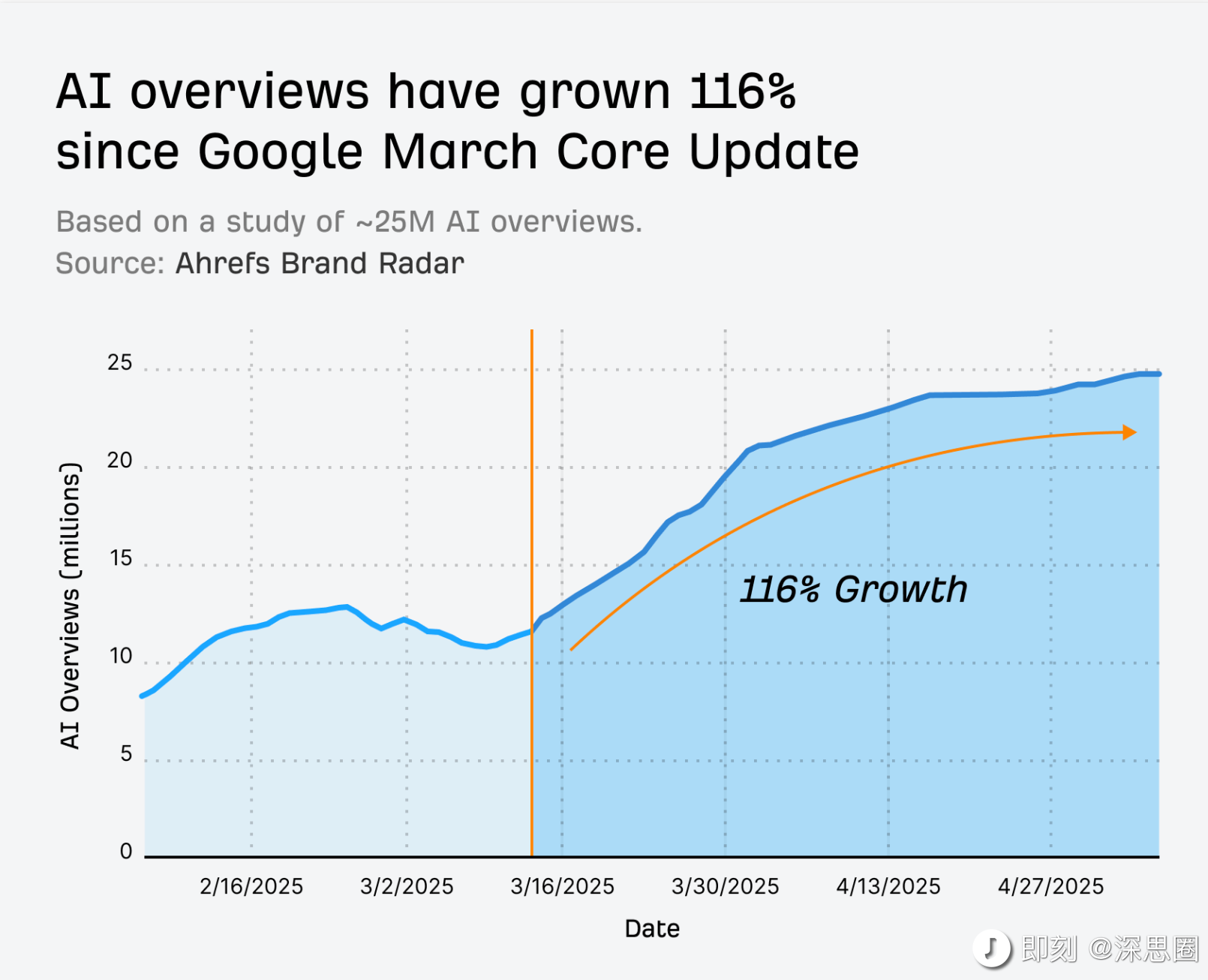
Have you ever thought that the $80 billion SEO industry might be heading towards its end? The search rules we have taken for granted for over two decades—keyword rankings, backlinks, page optimization—are being completely overturned by a brand new set of rules. When Apple announced the integration of AI-native search engines like Perplexity and Claude into Safari, Google's long-standing distribution monopoly began to waver. We are witnessing the most significant paradigm shift in the history of search: moving from a link-based search era to an era of Generative Engine Optimization (GEO) driven by language models.
This is not a gradual improvement but a complete rewrite. Imagine that in traditional search, success means your webpage appears at the top of search results. But in the GEO era, the definition of success has completely changed: Is your content directly cited in AI-generated answers? Does your brand hold a significant position in the model's "memory"? This shift is reshaping the entire digital marketing ecosystem, from content creation strategies to metrics for measuring brand visibility; everything needs to be rethought. What I see is not just a technological update but a fundamental reconstruction of business models and competitive landscapes.
The most important aspect of the transition from SEO to GEO is the change in traffic distribution channels. For someone involved in marketing and growth, the most sensitive issue is channel changes; every new channel that emerges signifies a new wave of traffic opportunities. Recently, I shared some of the latest data and insights from Google AI Overview on Jike, and interested friends can refer to the image below. A16z just published a new article today discussing how the emergence of GEO is changing the rules of traffic and marketing, which I would like to share along with some of my thoughts and insights.

The Leap from the Link Era to the Language Model Era
Traditional search is built on links, while GEO is built on language understanding. This difference may seem subtle, but it represents two completely different worldviews. In the SEO era, visibility meant ranking high on search results pages, which required optimizing page rankings through keyword matching, content depth and breadth, backlinks, user experience, and other factors. But today, as large language models like GPT-4o, Gemini, and Claude become the primary interface for information retrieval, the meaning of visibility has fundamentally changed: you need to appear directly in the answers themselves, rather than just ranking high on the results page.
I find that the impact of this shift is far deeper than it appears on the surface. The change in answer formats has completely altered people's search behaviors. AI-native search is showing a trend of fragmentation across various platforms, with Instagram, Amazon, and Siri driven by different models and user intents. User queries are becoming longer (an average of 23 words, compared to just 4 words in traditional search), search sessions are deeper (averaging 6 minutes), and responses vary based on context and source. Unlike traditional search, large language models possess the ability to remember, reason, and provide personalized multi-source comprehensive responses. This fundamentally changes how content is discovered and how it needs to be optimized.
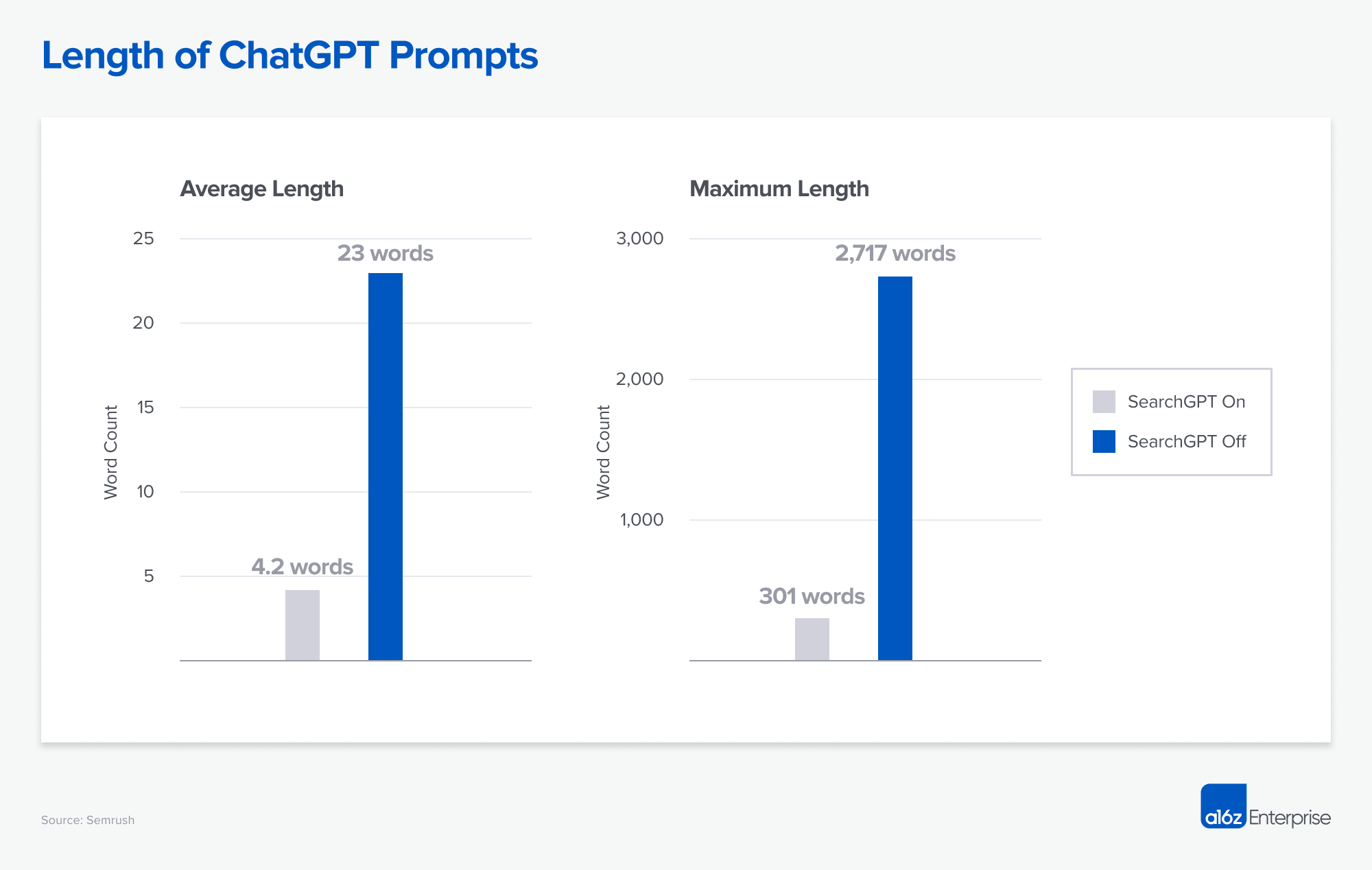
More importantly, the large language model market is fundamentally different from the traditional search market in terms of business models and incentive mechanisms. Classic search engines like Google monetize user traffic through advertising, with users paying with their data and attention. In contrast, most large language models are subscription-driven services behind paywalls. This structural shift affects how content is cited: model providers have little incentive to showcase third-party content unless it enhances user experience or reinforces product value. While the advertising market may eventually appear on large language model interfaces, its rules, incentive mechanisms, and participants are likely to differ significantly from traditional search.
In this new environment, I have observed an interesting phenomenon: traditional SEO rewards precision and repetitiveness, while generative engines prioritize well-organized, easily parseable, and meaning-dense content (not just keyword-dense). Phrases or bullet point formats like "summary" help large language models effectively extract and replicate content. This difference reveals the fundamental adjustments needed in content optimization strategies: shifting from catering to algorithms to catering to language understanding systems.

I believe one of the most noteworthy emerging signals is the outbound click-through rates from large language model interfaces. For example, ChatGPT has been driving referral traffic to thousands of different domains. This indicates that even in an era where AI directly answers questions, high-quality original content still holds value, but the way this value is realized is fundamentally different from the past. Brands and content creators need to rethink how to create and maintain their value in this new ecosystem.
The Shift from Ranking to Model Relevance
The current game rules are no longer just about click-through rates; they are about citation rates: how often is your brand or content cited or used as a source in model-generated answers? In a world of AI-generated outputs, GEO means optimizing the content that models choose to cite, rather than just whether or where you appear in traditional search. This shift is redefining how brand visibility and performance are measured.
I see new platforms like Profound, Goodie, and Daydream emerging, allowing brands to analyze their performance in AI-generated responses, track sentiment trends in model outputs, and understand which publishers are influencing model behavior. These platforms work by fine-tuning models to mirror brand-relevant prompt language, strategically injecting top SEO keywords, and running synthetic queries at scale. The outputs are then organized into actionable dashboards to help marketing teams monitor visibility, information consistency, and competitors' share of voice.
Canada Goose has used such tools to understand how large language models cite the brand—not just product features like warmth or waterproofing, but also brand recognition itself. The key insight is not how users discover Canada Goose, but whether the model spontaneously mentions the brand, which is an indicator of unassisted brand recognition in the AI era. This monitoring has become as important as traditional SEO dashboards. Tools like Ahrefs' Brand Radar now track brand mentions in AI overviews, helping companies understand how they are positioned and remembered by generative engines.
Semrush has also launched a dedicated AI toolkit aimed at helping brands track recognition on generative platforms, optimize AI visibility content, and quickly respond to new mentions appearing in large language model outputs. This indicates that traditional SEO players are adapting to the GEO era. We are witnessing the emergence of a new type of brand strategy: not only considering public recognition but also recognition within models. How you are encoded into the AI layer is the new competitive advantage.
Currently, GEO is still in the experimental stage, much like the early days of SEO. Each major model update carries the risk of relearning (or forgetting) how to best interact with these systems. Just as Google's search algorithm updates once prompted companies to scramble to respond to ranking fluctuations, large language model providers are still adjusting the rules behind their model citation content. Various ideas are emerging: some GEO strategies are already quite clear (e.g., being mentioned in source documents cited by large language models), while other hypotheses are more speculative, such as whether models prioritize news content over social media content, or how preferences vary with different training sets.
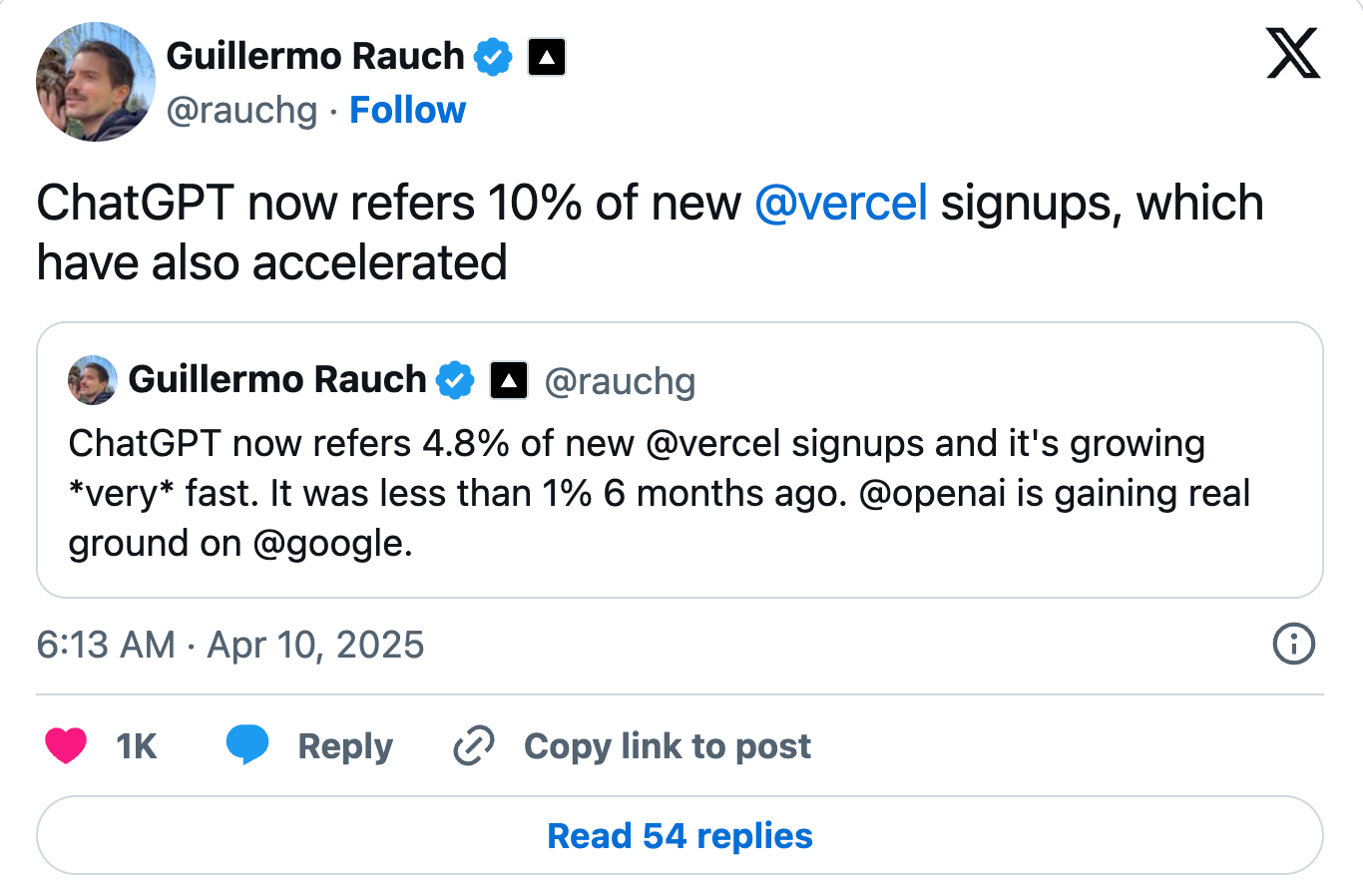
I believe this uncertainty is both a challenge and an opportunity. For brands that can quickly adapt and experiment, this is a time to gain a first-mover advantage. However, investment decisions need to be more cautious, as strategies that are effective today may not be applicable tomorrow. This requires marketing teams to cultivate stronger adaptability and a spirit of experimentation, rather than relying on fixed best practices.
Lessons Learned from the SEO Era
Despite the vast scale of the SEO market, it has never produced a monopolistic winner. This phenomenon has inspired me greatly. Tools that help companies with SEO and keyword research, such as Semrush, Ahrefs, Moz, and Similarweb, have all achieved success in their respective fields, but none have completely dominated the entire tech stack (or grown through acquisitions, like Similarweb). Each company has carved out its own niche: backlink analysis, traffic monitoring, keyword intelligence, or technical audits.
SEO has always been fragmented. Work is distributed among agencies, internal teams, and freelancers. Data is chaotic, and rankings are inferred rather than verified. Google holds the keys to the algorithm, but no vendor fully controls the entire market. Even at its peak, the largest SEO players were merely tool providers. They lacked user engagement, data control, or network effects to become the center of SEO activities. Clickstream data—the record of users clicking links while browsing websites—can be said to be the clearest window into understanding real user behavior. However, historically, this data has been difficult to access, locked behind ISPs, SDKs, browser extensions, and data brokers. This made it nearly impossible to build accurate, scalable insights without deep infrastructure or privileged access.

GEO changes all of this. The key to this transformation is that the way large language models operate is inherently more transparent and predictable. While we cannot fully understand the internal workings of the models, we can understand their behavioral patterns through large-scale queries and analyses. This creates opportunities for a new generation of tools and platforms that can provide more precise and actionable insights than those available in the SEO era.
Winning platforms in GEO will go beyond brand analysis to provide actionable infrastructure: real-time generation of marketing campaigns, optimization of model memory, and daily iterations that adjust to changes in large language model behavior. These systems will be operational. This unlocks a broader opportunity than visibility alone. If GEO is the way brands ensure they are cited in AI responses, it is also the way brands manage their ongoing relationship with the AI layer itself. GEO becomes a record-keeping system for interacting with large language models, allowing brands to track their presence, performance, and outcomes on generative platforms. With that level, you have the budget behind it.
The Rise of GEO Tools and Platform Opportunities
This is not just a tool transformation; it is a platform opportunity. I believe the most competitive GEO companies will not be satisfied with mere data measurement capabilities. They will build their own model fine-tuning capabilities, learning from billions of implicit prompts across industries. They will have a complete closed loop—insights, creative input, feedback, iteration—using differentiated technology not only to observe large language model behavior but also to actively shape that behavior. More critically, they will find ways to acquire clickstream data and integrate first-party and third-party data sources.
In my view, this is where the potential for monopoly lies: not just providing insights but becoming the channel itself. If SEO is a decentralized, data-adjacent market, then GEO may be the opposite—centralized, API-driven, and directly embedded in brand workflows. GEO itself may be the most obvious wedge, especially as we see shifts in search behavior, but ultimately, it truly cuts into the broader field of performance marketing. The guiding principles of brands supporting GEO and understanding user data can also drive growth marketing. This is how large enterprises are built, with software products capable of testing multiple channels, iterating, and optimizing between them. AI enables autonomous marketers.
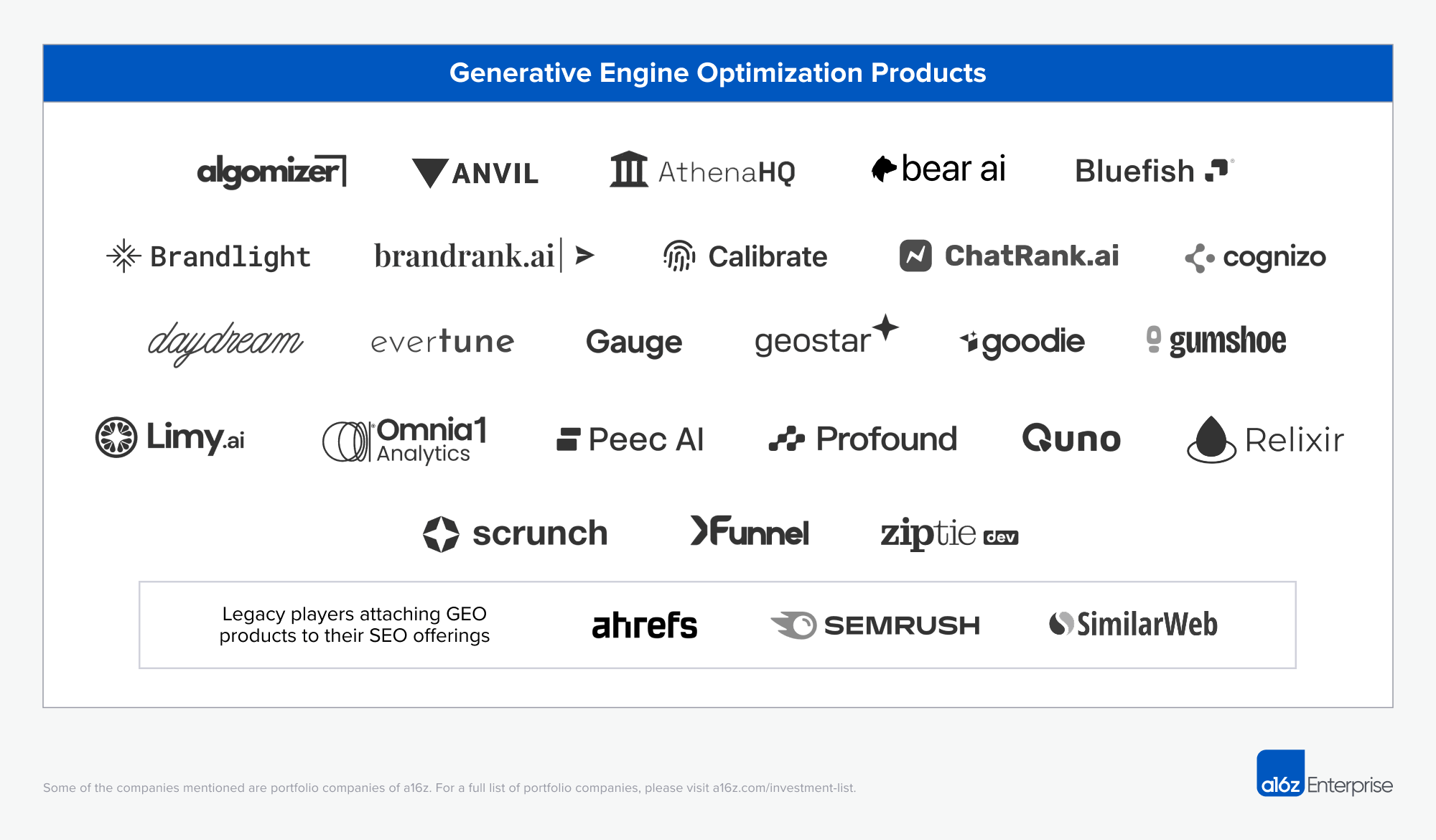
Timing is crucial. Search is just beginning to transform, but advertising funds move quickly, especially when there are arbitrage opportunities. In the 2000s, that was Google’s AdWords. In the 2010s, it was Facebook’s targeting engine. Now, in 2025, it is large language models and platforms that help brands navigate how their content is ingested and cited by these models. In other words, GEO is the competition to enter model thinking.
One key trend I have observed is that successful GEO platforms are evolving from mere analytical tools into full-stack marketing operating systems. They not only inform brands about their performance in AI responses but also provide tools for creating, optimizing, and distributing content to enhance visibility in generative engines. This integrated approach creates stronger customer lock-in and higher lifetime value.
More interestingly, I see some GEO platforms beginning to explore predictive capabilities. By analyzing the behavioral patterns of large language models, they can predict which types of content are more likely to be cited in future queries and which topics are about to become popular. This forward-looking capability provides brands with a significant strategic advantage, allowing them to position themselves favorably ahead of competitors.
I believe the real opportunity lies in platforms that can integrate GEO with a broader marketing tech stack. When GEO tools can seamlessly integrate with CRM systems, content management platforms, social media management tools, and analytics dashboards, they transform from standalone optimization tools into the core hub of marketing operations. This integration not only improves efficiency but also creates new data insights and automation possibilities.
The Future of Marketing: Brand Memory Competition in the AI Era
In a world where AI becomes the front door to business and discovery, the question marketers face is: Will the model remember you? This question is more profound and complex than it appears. It concerns not only brand awareness but also the brand's position within AI systems, the context in which it is cited, and its relative importance compared to other brands.
I find that the nature of this competition is fundamentally different from traditional marketing. In the SEO era, brands competed for positions on search results pages. In the social media era, brands competed for user attention and engagement. But in the GEO era, brands compete for the position and weight assigned to them in the "memory" of AI models. This is a whole new dimension of competition that requires new strategic thinking.
Interestingly, this competition occurs not only among brands within the same industry but also across industries. When users ask for "the best investment options," traditional financial brands may need to compete with tech companies, real estate platforms, and even cryptocurrency projects for AI citations. This cross-industry competition blurs traditional industry boundaries and requires brands to rethink their positioning and value propositions.
I believe successful GEO strategies must be built on a deep understanding of how AI systems work. This includes not only technical understanding but also insights into AI training data, update frequencies, and bias tendencies. Brands need to understand the characteristics and preferences of different AI models just as they understand Google’s algorithms. For example, some models may favor authoritative content, while others may prioritize novelty or practicality.
In the long run, I believe GEO will give rise to entirely new marketing professions and skill sets. Just as SEO experts have become standard in digital marketing teams over the past two decades, GEO experts will become indispensable roles in future marketing teams. These experts will need a deep understanding of AI technology, data analysis capabilities, content strategy thinking, and agility to quickly adapt to technological changes.
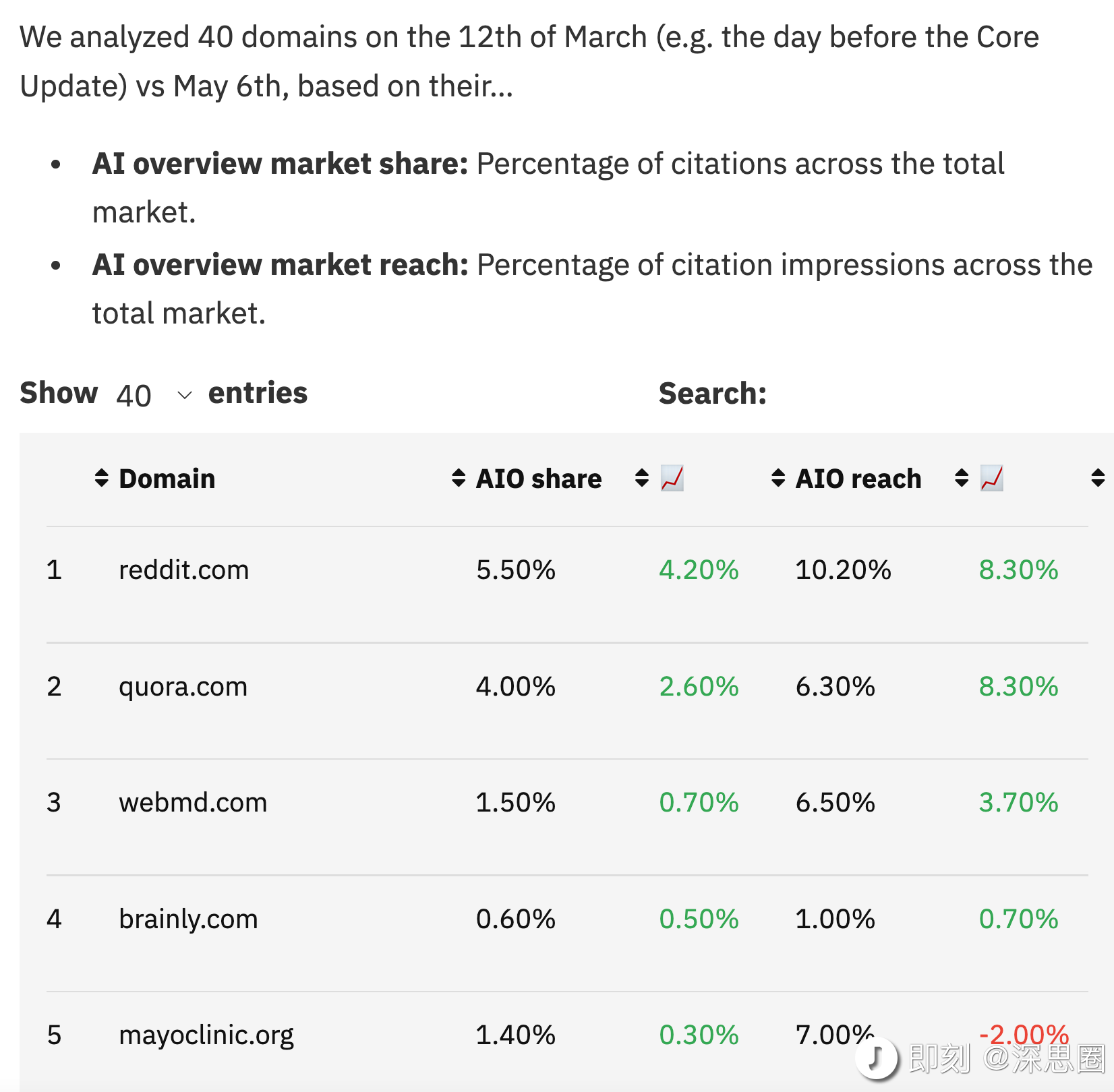
I also see the profound impact of GEO on content creation. Traditional content marketing focuses on creating content valuable to human readers. In the GEO era, content needs to be valuable to both human readers and AI systems. This requires content creators to master new skills, understanding how to create content that attracts human readers while also being effectively understood and cited by AI systems.
Ultimately, GEO is not just a new marketing strategy; it represents a fundamental shift in the way brands interact with consumers. In this new world, a brand's success no longer depends solely on how many consumers it can reach, but on whether it can be chosen and recommended by AI systems at critical moments. This shift requires brands to reassess their value propositions, content strategies, and technology investments to ensure they remain competitive in an AI-driven future.
I firmly believe that brands that can early understand and master the rules of GEO will gain a significant competitive advantage in the coming years. Those that cling to traditional marketing thinking may find their visibility in the AI era sharply declining. This is not alarmism but an inevitable result of technological transformation. The GEO era has arrived, and the rules of the game have changed. The key question is: Are you ready?
免责声明:本文章仅代表作者个人观点,不代表本平台的立场和观点。本文章仅供信息分享,不构成对任何人的任何投资建议。用户与作者之间的任何争议,与本平台无关。如网页中刊载的文章或图片涉及侵权,请提供相关的权利证明和身份证明发送邮件到support@aicoin.com,本平台相关工作人员将会进行核查。




